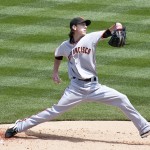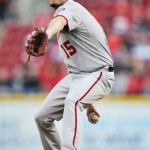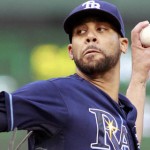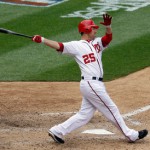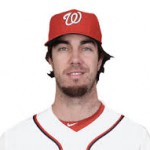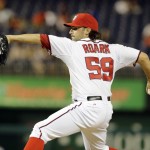One of the more intriguing FA situations for the coming off-season was resolved incredibly early, with Tim Lincecum signing 2yr/$35M deal to stay with the San Francisco Giants for two more years. Lincecum also gets a full no-trade thrown in.
$17.5M a year for a guy whose last two seasons looked like this:
– 2012: 10-15, 5.18 ERA, 1.468 Whip and a 68 ERA+. -1.7 bWAR
– 2013: 10-14, 4.37 ERA, 1.315 Whip and a 76 ERA+. -0.6 bWAR
His fastball velocity, once a strength, rank him 62nd out of 81 qualified starters in 2013. He was averaging 93-94 with a peak of 99 earlier in his career; now he’s averaging 90.2 and peaking 94.3. That’s a huge, significant velocity loss that hasn’t been accompanied by any D/L stint or time off. He’s 29, he’s got incredibly weird (lets call them “unique” to be nice) mechanics and he’s coming off of two seasons where he’s pitched like a 4-A pitcher, well below replacement value. I’m sorry, but why would anyone believe at this point that he’s got any shot of returning to his Cy Young glory?
Now, you can argue that his more advanced numbers (Fip, xFIP, Siera) aren’t as damning as the traditional numbers I posted above (this is exactly what Dave Cameron does in one of the reaction links located at the bottom of this post). And you’d be right to a certain extent. By xFIP for 2013 he’s ranked 29th of 81 qualified starters. By FIP he’d be ranked 45th, and by SIERA 35th. None of those are elite placements for the year. It still don’t make Lincecum a $17.5M/year arm. And, that’s putting an awful lot of faith in the xFIP, if that’s your argument. Because we’ve seen plenty of pitchers whose xFIPs always trail their FIPs (and Lincecum pitches in SF, where homers go to die). And we’ve seen pitchers whose FIP is improved because they get more K’s than ground ball outs (and Lincecum is still a high strikeout pitcher, so his FIP will always look better). And one final rebuttal; xFIP is an estimator of future performace, not a guaranteer of it. Look at Lincecum’s career and his xFIP-next year’s ERA link is all over the place. To blindly look at his 2013 xFIP and predict that he’s returning to form is, well, foolish. And none of these arguments apologizes for his negative WAR values the last two years; hey Sabre-nerds; you can’t pick and choose stats to approve this and leave out your favorite one.
I wouldn’t have given him half the guaranteed money the Giants just did. I wouldn’t have even given him a Q.O., because its hard for me to believe someone out there would have given him even $14M guaranteed for 2014.
Here’s another stat line to consider:
– 2013: 10-14, 4.67 ERA, 1.238 WHIP, 81 ERA+, -0.1 bWAR.
Comparing this stat line straight up with Lincecum’s 2013, you’d clearly think this pitcher would be more in line to get paid than Lincecum, right? This stat line belongs to none other than Dan Haren. Who thinks Haren is scoring a 2 year/$35M deal this off-season? Who here thinks Haren even gets a 1 year/$8M deal? Certainly Haren’s not going to get a Qualifying Offer out of the Nats this fall.
Other opinions on the deal: Hardballtalk advised not to “freak out” about the contract, that there’s so much money in the game and blah-blah. Sorry, this isn’t about salary escalation (if you wanted to talk about that, lets talk about the Hunter Pence deal … a clear example to me of salary escalation for a good but not great player). Dan Symborski at ESPN hates the deal with pretty good points about the timing, the lack of a Q.O., the lack of a market for him, etc. Keith Law points out that the contract seems like a “thanks for the memories” contract, not one that will actually help the Giants win. Gwen Knapp on SportsonEarth points out the sentimentality of the deal. Dave Cameron points out that Lincecum’s xFIP makes him actaully more valuable than his traditional numbers appear. Maybe we’re the dumb ones and the Giants are the smart ones. Rob Neyer tries really hard not to be harsh about the contract. And lastly unabashed SF homer Grant Brisbee chimes in.
Giants GM Brian Sabean has long had a bad rap in the blogosphere as being one of the poorest GMs in the game. And then his team went and won the World Series two years out of three. But moves like this bring back questioning of his competence. Unless he throws his owner under the bus and washes his hands of the deal, if that’s indeed the case.
